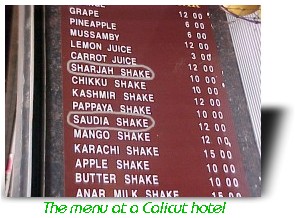It has been argued that modern university is an Arab invention. For instance, the Islamic institutions of learning gave the source of the idea of calling together student from many lands… more important still is the universal validity of qualifications as an Arab concept. Equally certain is that Mathematics derives from Arabic roots.
The Harbinger of Arabian legacy rekindles the memories of Spain.
Upon arrival at the foundation, Sheikh Sultan was received by a number of chairmen of Arab and Islamic cultural centers in Western Europe, north and South America.
The Menu at a Hotel
The Indo Arab relations which began centuries continue to express itself in different dimensions. It maybe in the form of forms like dress, place names or even people’s names- these are only a form of indirect cultural symbiosis. 
It is only natural for this to happen when two cultures meet or rather merge with one another. Most of the changes has been due to historical reasons as well. However a simple, yet significant, change which caught my attention was the names of fresh fruit juices that are getting popular in Kerala due to the rising heat of summers. [it is not in the scope of MeraWatan to discuss environmental issues like global warming 🙂 ]
Throughout Kerala, two fresh juices are very popular for their taste as well as their names. “Sharjah” and “Saudi” are the favorites of Keralites, especially during summers. “Sharjah” is a sweet shake of bananas and milk with plenty of sugar whereas Saudi is dates mixed with milk. Sharjah is the first choice of the majority as far as I have seen.
Who guided Vasco Da Gama to India ? Not an An Arab !
Supreme Council Member and Ruler of Sharjah His Highness Dr Sheikh Sultan Bin Mohammed Al Qassimi has written a book that has come from his research to bring out the truth on who really showed famed Portuguese explorer Vasco Da Gama the sea route to India.
Talking about his book at the 19th International Book Fair in the Sharjah Expo Center, Sheikh Sultan said the title was Bayan Lil Muarrikin Fi Barat Ibn Majid about famous Arab voyager Ibn Majid and the truth about whether Ibn Majid guided the Portuguese explorer on the route to India. “It was not Ibn Majid but a man from Gujarat state in India who actually took Da Gama to India,” he said.
“What made me write this book was an incident where I was giving a lecture in Sharjah University and I happened to say that an Indian took Da Gama to India,” Sheikh Sultan said, adding “just then, one of the students said the researchers refused to accept this fact and continued to maintain that Ibn Majid has shown the Portuguese explorer the way to India.”
“Realizing that in schools and elsewhere teachers would continue telling students that Ibn Majid showed Da Gama the way the India, I decided to search for proof that it was not Ibn Majid but another man who had shown the way. Finally, in a very old library in Portugal, I found an old dairy describing the trip of Ibn Majid and Vasco Da Gama. The story revealed how they found the way to India and clearly mentioned that another man – not Ibn Majid – had shown them the way to India.“, Sheikh Sultan added. Da Gama had landed in Kappad, Calicut in 1498.
He said that all money from the sale of his book would go towards the Sharjah City for Humanitarian Services.
A special library would be set up for the cause of Palestine and it would be part of the Central Library in Sharjah where all books referring to the Palestine issue would be collectively displayed, he said.
Source : The Gulf Today November 2nd 2000
The Cultural Architect marches across cultural boundaries
Sept. 6th 2002.
Dr. Sheikh Sultan bin Mohammed Al Qassimi inaugurated an Arabic calligraphy Exhibition held on the sidelines of the first International Conference on Middle East studies.
Sharjah participated with 30 works of calligraphy the from the museum of Sharjah. The opening was attended by the education minister of German province of Rheinland Pflatz.
He also visited the Johannes Museum in Gutenburg and the Roman Ships Museum, established in 1900. the Museum is one of the oldest which monitors the history and development of printing works throughout the history of mankind. Sheikh Sultan also saw the archaeological pieces of Holy Quran, the bible and a legacy of history, Islamic and Christian books.
He was told that Arabs and Muslims knew and practiced printing works nearly 500 years before Gutenberg.
The officials at the museum revealed that the museum has a printed chapter of the Holy Quran, which was printed in the year 1000 AD by Muslims in Egypt. They were followed by the Chinese in the year 1100 AD, before the Gutenberg printed a copy of the Bible in 1452, the official told.
Before leaving Germany, he commended the Johannes University of Gutenberg for organizing the first international conference on middle east studies. He urged officials of the Arab universities, cultural centers and museums to interact with the German people, who crave to know more about the Arab and Islamic worlds.